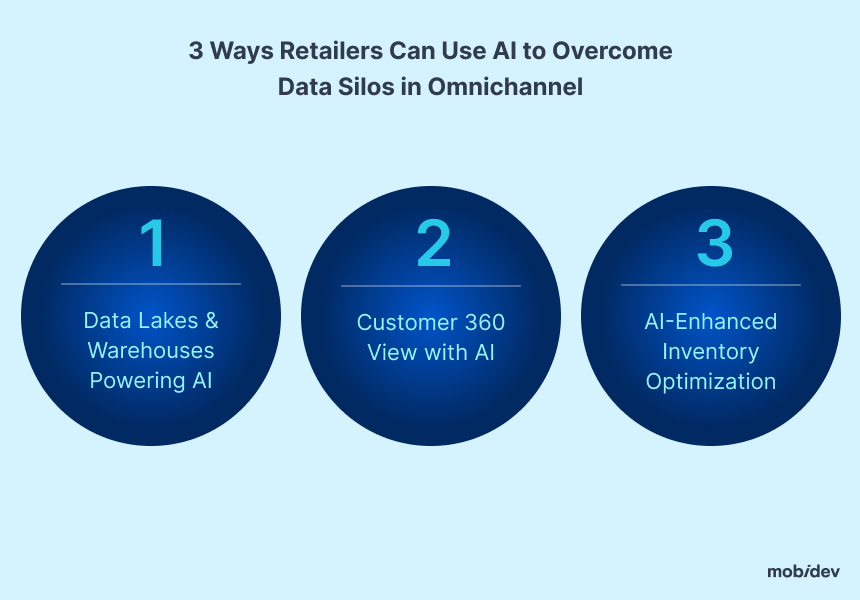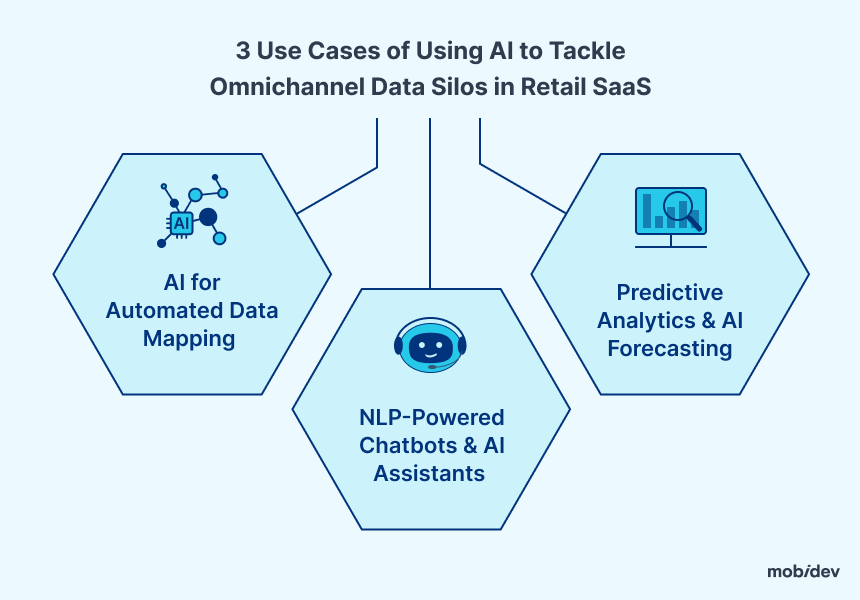Omnichannel retail aims to provide shoppers with a consistent, personalized experience across every channel—brick-and-mortar, mobile apps, websites, and social media. In reality, many retailers end up with fragmented data that undercuts this vision. Marketing teams might store information in one system, while supply chain data remains locked in another. These disconnected systems create data silos, obstructing a unified view of the business and causing real pain points such as stock inaccuracies and uneven customer experiences.
Retailers and Retail SaaS providers alike face these challenges. Large retailers often juggle multiple legacy systems that don’t talk to each other. Meanwhile, SaaS companies must integrate data from diverse client platforms. As the complexity increases, data silos multiply. In this article, we’ll explore how to break data silos with AI so both retailers and SaaS providers can turn chaos into seamless omnichannel operations. I’ve worked on complex software projects in healthcare, fintech, social networks, and especially retail, building scalable solutions that unify siloed systems. From my experience, AI stands out as one of the most efficient methods to tackle data fragmentation.
Understanding Data Silos in Omnichannel Retail
Omnichannel retail is intended to centralize customer experiences and data. All channels—from physical stores and loyalty apps to social media—should converge into one cohesive ecosystem. However, this ideal is hard to achieve. The complexity of managing diverse tools and technologies often results in data silos in retail.
Retailers commonly use separate systems for different channels, making it difficult to unify and analyze information. Legacy systems, still dominant in many organizations, may not integrate smoothly with modern APIs. Inconsistent data standards between departments compound the issue, especially when urgent decisions need to be made based on reliable, up-to-date information. Added to this are departmental barriers and compliance rules that restrict data sharing.
When these silos persist, omnichannel retail ends up broken:
- Customers might see different prices or promotions on different channels.
- An item bought online cannot be returned in-store because the systems don’t synchronize.
- Real-time inventory data is virtually impossible to maintain, leading to overselling or out-of-stock incidents.
- Marketers, sales teams, and customer service reps rely on incomplete insights, crippling personalization and cross-selling.
The Role of AI in Breaking Down Data Silos in Retail
There are many methods of breaking down data silos from shifting corporate culture to building IT systems that enable data integration. Artificial Intelligence is transforming how businesses handle fragmented data. Whether you operate as a large retailer or a Retail SaaS provider, AI can unify your omnichannel strategies. AI can automate data workflows, clean up inconsistent records, and deliver predictive insights across your entire organization.
Businesses usually attack silos from two complementary angles:
- Enterprise-scale data storage, such as data lakes or data warehouses that collect raw, semi-structured, and structured information in one place.
- Domain-focused operational platforms—CRM, MDM, and CDP—designed to govern, enrich, and activate specific slices of that information (customers, products, campaigns).
Yet none of these tools eliminates silos on its own:
- Data lakes store raw information from multiple sources but are often too unstructured for immediate, actionable insights.
- Customer Relationship Management (CRM) systems focus on aggregating and managing customer interactions, yet they frequently struggle with data accuracy and real‑time engagement.
- Master Data Management (MDM) systems unify critical data—products, customers, suppliers—into a single authoritative source, but they may synchronize changes only after some delay.
- Customer Data Platforms (CDPs) excel at bringing together cross‑departmental data in real time, making them integral for targeted marketing and unified customer profiles.
However, all these systems function optimally only when data is accurate, consistent, and up to date. That’s where AI comes into play. AI-driven engines excel at collecting, transforming, and analyzing inconsistent and unstructured data of different formats. According to NVIDIA State of AI in Retail and CPG 2025, AI improved insights and decision-making for 43% of retailers, enhanced employee productivity and upskilling for 42%, and created operational efficiencies for 42%.
This is the evidence that intelligent data pipelines can remove manual inefficiencies and boost performance. This underscores just how pivotal AI can be in reshaping data strategies for retailers and SaaS providers.
AI Capabilities for Data Unification across Multiple Retail Sources
AI can integrate disparate data sources—including POS systems, CRM databases, online marketplaces, and supply chain software—into one unified environment. Data fragmentation becomes a smaller hurdle when machine learning algorithms and intelligent connectors are in place.
Automated data pipelines further support real-time synchronization. AI systems can react to client-side input and decide which platforms to pull data from, orchestrating transfers on demand rather than relying on scheduled batch jobs. Additionally, AI governance engines apply automatic data cleaning and deduplication so that only high-quality records enter your unified environment.
When such data flows are streamlined in this way, retailers can respond faster to inventory fluctuations, price adjustments, and consumer behaviors. SaaS providers, for their part, get the benefit of scalability in terms of onboarding new customers or new channels without redoing the integrations.
AI-Powered ETL: The Key to Breaking Data Silos in Retail
Traditional ETL (Extract, Transform, Load) processes often rely on manual coding and scheduled tasks. They are prone to errors when source schemas change or new data types appear. This can stall real-time updates and create mismatched data sets—fuel for more silos.
AI-powered ETL automates large chunks of this workflow and, crucially, decides which data sources to tap based on the incoming task:
- The AI engine identifies data patterns and structures in diverse systems.
- Inconsistencies or missing values are flagged and either auto-corrected or routed for review.
- Data transformation rules adapt dynamically to updates in the source schema.
By offloading repetitive data tasks to AI, you slash integration downtime and maintain higher data quality. This lays the foundation for consistent, company-wide analytics and more fluid omnichannel experiences.
Role of Machine Learning in Identifying Patterns & Inconsistencies in Siloed Data
Machine learning is adept at sifting through massive data sets to spot anomalies, duplicates, or irregularities. In the context of siloed retail data, ML models can:
- Detect duplicate or conflicting customer records. Usage patterns, purchase histories, and even geolocation data help confirm if two records actually represent the same person.
- Identify root causes of silo formation. By analyzing metadata and user behaviors, ML systems can pinpoint the processes or departmental practices that lead to isolated pockets of data.
- Improve data security and compliance. ML may identify suspicious access behavior or patterns of data usage that contravene GDPR, CCPA, PCI-DSS, and other legal regulations.
For retailers struggling with fragmented sales, marketing, and supply chain infrastructures, ML gives them a layer of visibility and monitoring. It tracks flows of data, detects erroneous records, and enables corrective measures before they jeopardize customers’ experiences.
AI-Driven Approaches for Seamless Omnichannel Marketing: A Retailer’s Point of View
AI gives retailers the tools to unify fragmented data, automate decision-making, and deliver consistent customer experiences—but it is not a silver bullet. Turning algorithms into real business value still demands skilled hands and well-planned infrastructure.
That’s why experienced teams matter. Experts must provision secure pipelines so that AI can reach disparate data sources, tune and retrain AI agents to minimize errors, monitor performance around the clock, and harden every component against security vulnerabilities or throughput bottlenecks that automated mapping can introduce. When these foundations are in place, AI becomes a catalyst rather than a gamble. Below are key solutions that help eliminate data silos in omnichannel retail.
1. Data Lakes & Warehouses Powering AI
A practical first step in how to break data silos with AI is consolidating data into centralized storage. AI-enabled data lakes and warehouses create a single repository for all your operational information. Real-time synchronization ensures that the data entering these hubs is both current and standardized.
By eliminating the need to bounce between isolated systems, retailers can visualize and analyze data more holistically. You reduce the risk of contradictory numbers on sales dashboards and unify performance metrics for better strategic decisions.
2. Customer 360 View with AI
A hallmark of omnichannel success is having a unified, 360-degree view of the customer. This goes beyond simply merging demographic details. AI can:
- Compile data from physical stores, online listings, and loyalty programs.
- Combine that information with behavioral data, like clickstream or shopper location.
- Use machine learning to build in-depth customer profiles that update in real time.
With a complete, AI-driven profile of each customer, retailers can align marketing, sales, and customer service more effectively. Promotional messages on mobile apps reflect the same preferences and past purchases recognized at in-store registers. Personalized offers become consistent, avoiding the confusion of disjointed promotions.
3. AI-Enhanced Inventory Optimization
Inventory mismanagement is a major source of financial loss. AI for data silos in retail helps you see the entire chain—orders, shipments, warehouse levels, and in-store stock—through a single lens. Machine learning models crunch historical sales trends alongside real-time demand signals.
Retailers thus anticipate surges or dips in specific SKUs before they occur:
- Predictive analytics flag potential stockouts or overstocks in time for corrective action.
- Automated reallocation ensures that if one location is overstocked, it can transfer goods to another location with higher demand.
- BOPIS (Buy-Online-Pickup-In-Store) enablement becomes simpler, as inventory data remains accurate across channels.
Such streamlined AI inventory management not only cuts costs, but also heightens customer satisfaction by reducing unavailable product listings or shipping delays.
AI-Driven Approaches for Seamless Omnichannel Marketing: Retail SaaS Point of View
Retail SaaS platforms face a unique set of challenges in consolidating data from numerous clients, each with its own tech ecosystem. AI significantly eases these burdens by unifying processes, predicting trends, and enabling advanced insights for all stakeholders.
1. AI for Automated Data Mapping
One pressing issue for Retail SaaS providers is the varying data formats used by different retailers. Manual mapping is time-consuming and error-prone, especially when you onboard multiple clients.
AI-driven data mapping systems can:
- Recognize data types and structures across different retailer platforms
- Automatically align them with a master data schema
- Continuously adapt to changes, eliminating extensive re-coding efforts.
This automation reduces integration times, allowing SaaS companies to scale faster and maintain high-quality data despite wide variation in client systems.
2. NLP-Powered Chatbots & AI Assistants
Unified customer support is another area where data silos in retail SaaS can disrupt user experiences. Modern AI chatbots run on large language models (LLMs)—the latest evolution of Natural Language Processing (NLP). These LLM-based assistants combine language understanding and reasoning, enabling them to infer user intent, connect ideas, and solve multi-step queries instead of relying on simple pattern matching. As a result, they can:
- Access data from multiple channels—chat, email, call logs—in real time, stitching together context that would otherwise remain siloed.
- Offer consistent, accurate responses on any communication platform because the model both understands intent across languages, dialects, and phrasing, and applies structured logic to select the most relevant answer or action.
- Hand off complex issues to human agents with a full conversational history attached, ensuring a seamless transition and eliminating repetitive questions.
For SaaS providers, these LLM‑driven tools become a built‑in differentiator. Instead of coding one‑off chat solutions for each retail client, you can deploy standardized, AI‑powered assistants that draw on unified data sources, delivering coherent, omnichannel support at scale.
3. Predictive Analytics & AI Forecasting
Retailers increasingly look to their SaaS partners for forecasting tools that can guide demand planning, pricing, and operational adjustments. AI-driven models for predictive analytics are invaluable here:
- Large historical data sets are processed to understand seasonal fluctuations and market influences.
- External variables—like local events or competitor promotions—can be factored into demand forecasts.
- Real-time updates allow for immediate recalibration, preventing stock emergencies or missed revenue opportunities.
By centralizing these predictive capabilities, SaaS providers position themselves as indispensable collaborators that eradicate silos and empower retailers with proactive, data-driven decision-making.

Learn Deeper:
AI Demand Forecasting for RetailHow You Can Break Down Data Silos in Omnichannel Retail with MobiDev’s Help
MobiDev equips you with best practices for seamless integration so fragmented data stops blocking growth. By unifying information flows and layering AI across your stack, you gain the clarity and agility needed to delight customers on every channel.
Not sure which approach to apply to break data silos? Leverage our AI Consulting to plan the implementation of AI in your system and build a system that aligns with your business goals.
Have an AI implementation strategy for your data silos but lack talent to carry it out? Explore MobiDev’s retail software development services and get your dream team equipped with the necessary skills and experience to handle your project.
For Retailers
You can modernize legacy systems into cloud‑native, real‑time architectures where point‑of‑sale, campaign analytics, and supply‑chain updates converge in a single data lake or warehouse. With MobiDev’s help in building AI‑powered ETL pipelines and smart connectors, you align promotions, inventory, and loyalty programs without manual wrangling—giving every teammate, from store associate to CFO, accurate insights the moment they’re needed.
For Retail SaaS Providers
Your multi‑tenant platform can maintain strict data isolation while delivering fast, AI‑driven analytics. MobiDev helps you embed encryption and secure data‑sharing protocols that meet PCI‑DSS, GDPR, and CCPA requirements. Automated data mapping, normalization, and predictive modules let you onboard new retailers quickly and provide them with consistent omnichannel experiences—making your product indispensable as clients see fewer silos, stronger compliance, and sharper forecasts.
By attacking the root causes of data silos—fragmentation, compliance risks, and operational blind spots—you gain the resilience to thrive in today’s competitive retail landscape.







